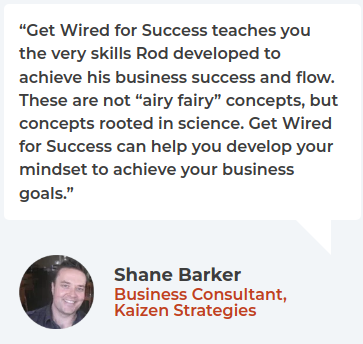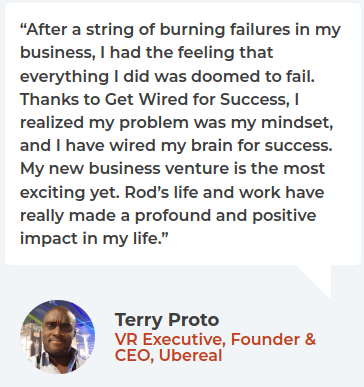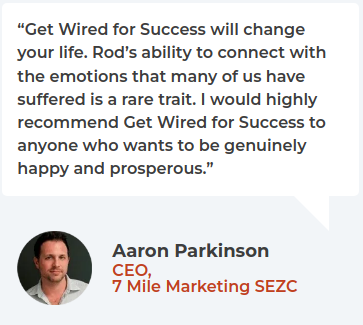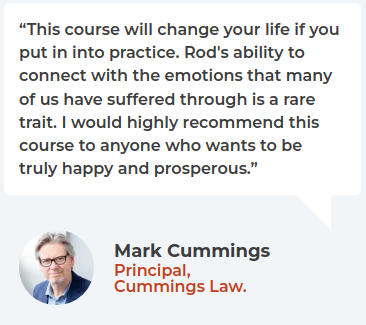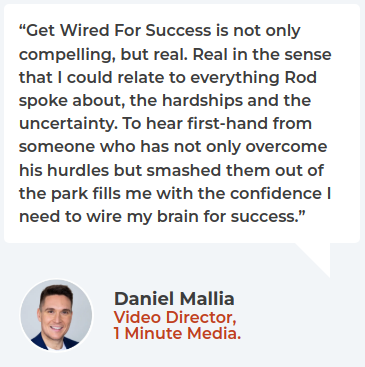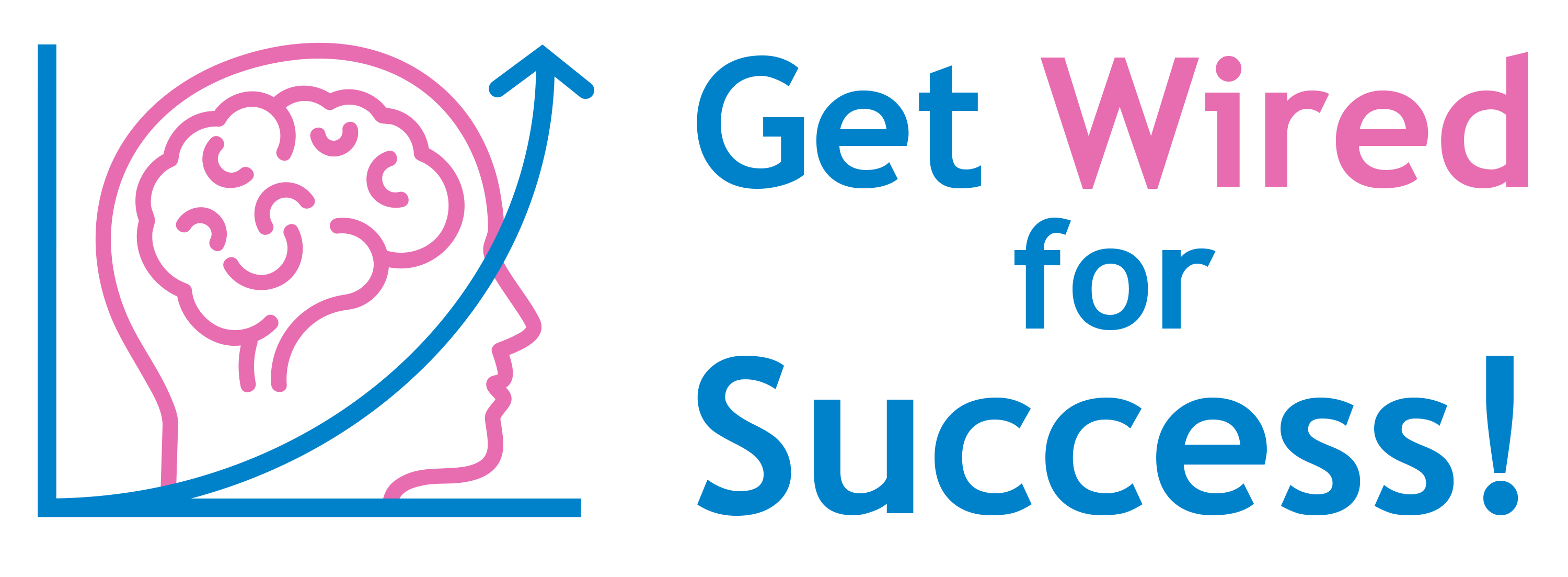Discover The 12 Keys to Unlock the Awesome Potential of Your Brain
We get an Instruction Manual for Everything Else. The 12 Keys are an Instruction Manual for Your Brain
Wondered Why Books, Mindset Training, and Other On-line Courses FAIL to Wire Your Brain for Success? They ALL Lack 12 Scientifically Proven Keys

![]() Before I tell you more about the 12 keys, and how they can change your life, let me tell you a little bit about myself and how I discovered this amazing method.I purchased my first business for over a quarter of a million dollars, and soon discovered it was losing money.With no training in business management, I plunged on...
Before I tell you more about the 12 keys, and how they can change your life, let me tell you a little bit about myself and how I discovered this amazing method.I purchased my first business for over a quarter of a million dollars, and soon discovered it was losing money.With no training in business management, I plunged on...
Eight years later I was over one million dollars in debt.It nearly killed me.I experienced crippling anxiety, mind-numbing insomnia, even a near death experience!Then my big breakthrough.I discovered how to wire my brain for success with neuroscience and positive psychology. As a scientist, it was important to me that everything I tried was based on proven science. Not mindset training. Not hype, spin, or mumbo-jumbo!When I applied these lesser-known branches of science to my business, it totally changed everything.Happy clients were raving on about our services, I had a highly motivated dream team of employees (making my job even easier), and best of all a HUGE 721% jump in profits.I created the business and personal life of my dreams, and totally transformed myself into one of calmness, confidence and a love of living life to the fullest!I then sold the business a few years later because I wanted to share my success methodology with people just like you.I want you to experience the same level of success in your career, business and life just like I did...So, I've distilled more than 5 years of my research and science information into 12 simple keys to wire your brain for success... ![]()
Get All 12 Keys in the "Get Wired for Success" On-line Course:
Watch superbly illustrated videos containing in-depth lessons and coaching, divided into 4 convenient Units. Explore easy-to-understand science, the strategies and the tactics to Wire Your Brain the Business Success and Life of Your Dreams.
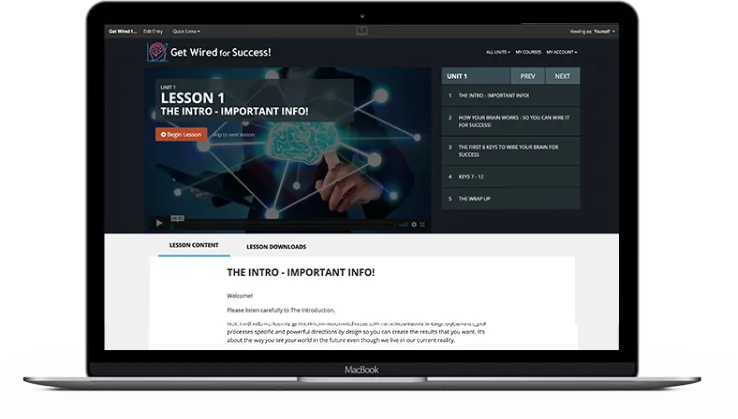
Unit 01How To Wire Your Brain For Success.
Know HOW Your Brain Works!
This is the ESSENTIAL Knowledge to Wire Your Brain for Success
Explore Neuroscience-Made-Easy:
Get 2 Little-known Facts that Open Up a Whole New World of Understanding and Possibility. Knowing these Facts is the Light Bulb Moment!
Get ALL 12 KEYS To Wire Your Brain for Amazing Success in Business and Life:
Unlock the Awesome Power of Your Brain with The 12 Essential, Powerful, Practical Keys—the Real Nuts and Bolts of this Course—All Based on Easy-to-understand SCIENCE!

Unit 02Dream Big! Then Turn Your Vision Into Reality.
Create a Crystal-clear Vision of Your Future
Know Where You are Going in Business and Life! It Makes Decision-making SO Much Easier.
7 Rules For Real Results
Transform Your Dreams of Success into Stunning Results!
Add Speed & Power To Your Vision
4 Magnifying Tools to Reach Your Dream Destination Faster, Easier, Less Expensively!

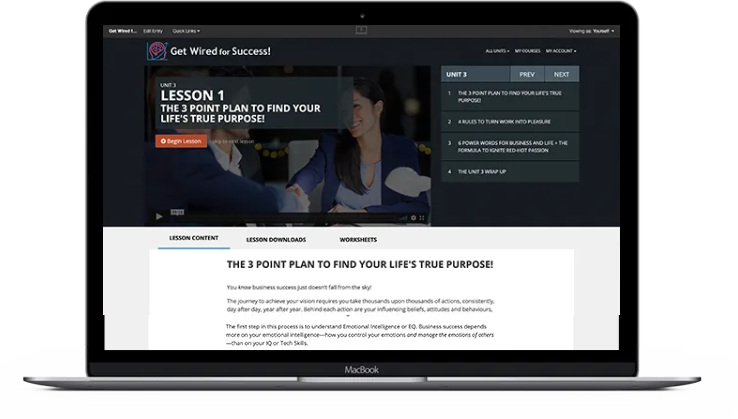
Unit 03Be On Fire With Purpose, Power & Passion!
Find Your Life’s True Purpose with this 3 Point Plan.
Discover the Secret to Sustained Motivation. Even in the Hardest of Times, Be Unstoppable!
Cut Boredom or Burn-out:
4 Rules To Turn Work Into Pleasure!
Discover Your 6 Power Words:
Harness Vital Energy for Courageous, Decisive, Authentic Conversations,
AND Ignite Red-hot Passion! Inspire Your Investors, Lead Your Team, Persuade Your Clients!

Unit 04How To Master Your Thoughts & Emotions!
Magnify Your Success in Business by 50%!
Get the X-Factor, and Max its Effect!
Discover the 3 Stages of Personal Transformation:
- Know What the Gurus Should Teach You!
- Get The “Software” To Program Your Mind For _________!! (Fill in this Space with the Outcomes You Desire!)
BONUS 1: Get My Emotion Mastery Formula: Conquer Pressure and Overwhelm with this Simple 3 Step Formula!
And BONUS 2: Know the 3 Signs of Success: Monitor Your Progress. This is So Important. Your Trajectory should be Ever Upward, Better, Faster. Here's How to Check!

Is there Anything Else Included in "Get Wired for Success"?
Yes, Look at These FREE and AWESOME Bonuses!
The 21 Steps are downloadable PDF exercises.Do the 21 Steps, and ACTIVELY WIRE your brain for success—GUARANTEED! Rid yourself of those self-imposed limitations, negative beliefs, tired, old mindsets, and even anxieties and fears holding you back from UNLEASHING your real potential.
Add SPEED and POWER to Reach Your Destination Faster with 4 Magnifying Tools—all based on how YOUR BRAIN WORKS.The 4 Magnifying Tools are designed not only to make your journey faster and easier, but more rewarding and ENJOYABLE TOO! And success is A LOT easier than mediocrity or failure! That’s for sure!
Look things up when you need help FAST, or want to REVISE. Revision EMBEDS what You have Learned.OPTIMIZE your thinking and emotions easily, saving you time and energy for a HOST of positive emotions—greater joy, gratitude, celebration, happiness and LOVE.
Can’t imagine Wiring Your Brain for Success? Problem solved!While we can’t see inside our head, the amazing graphics BRING THE PROCESS TO LIFE!Importantly, the graphics are applied to each of The 12 Keys, and ALL the other important business principles covered in the course—illustrating areas such as EMOTIONAL INTELLIGENCE, MOTIVATION AND YOUR POWERS OF VISUALIZATION.
Leading an INSANELY busy life? Stressed to the Max? Another problem solved with my Emotional Mastery Formula—a simple 3 step process so you can CONTINUE to wire YOUR brain for success while YOU WORK or PLAY!Now wire your brain for success ON THE RUN!
These are my personal stories of the Ups and Downs, the Triumphs and Disasters I have experienced along my journey to success.You have your OWN roadblocks, difficult people, and perhaps your own past to deal with.Use my Roadblock Busters as an example and framework. Your brain is extraordinarily adaptable. Now smash YOUR roadblocks, unleash your amazing potential, and create a life you LOVE!
Don't let this important information be forgotten in the busyness of life! The Wired for Success Manifesto is a super-short summary of The 12 Keys presented as a graphic. Stick it on the side of your printer, or as an image on your smart phone, ready to remind you when the pressure is ON!
Know your are making progress as you make your way through the course, and beyond, as you apply your new knowledge to business and life. The 3 Signs will tell you, you are on the right track!
Awesome Bonuses Saving Time, Effort, and Money!
The 12 Keys Will Wire Your Brain for the Business Success and Life of Your Dreams—Easily, Inexpensively, and in Less than 5 Weeks—Guaranteed!*
The 12 Keys Will Wire Your Brain for the Business Success and Life of Your Dreams—Easily, Inexpensively, and in Less than 5 Weeks—Guaranteed!*
And Check Out My Mind-blowing "Wired for Success" Guarantee!

Take this Course and all these Amazing Bonuses... Test Them Out for their Extraordinary Value.., and If for Any Reason You are Not Completely Blown Away in 365 Days.., I'll Let You Keep the Entire Course and All the Bonuses and Give You a 100% Refund, Credited to Your Card. Now THAT is an Insanely Good Offer!
-
"Get Wired for Success" is Founded on Proven Evidence-based SCIENCE and Best Business Principles and Practices. That's Why I can Be TOTALLY Confident It Will Work for You!
If You are in Any Doubt about this Amazing Offer, You Now have 3 Options
Option 1
You can Click Away and Go Back to How Things Were Before You Read these Words. But if You want to Experience Greater and Greater Success in Business and Life, there's...
Option 2
You can Try to Figure All this Stuff Out on Your Own. It took Me 5 Years of Study, a Lot of Trial-and-error and TENS of Thousands of Dollars to Wire My Brain for Amazing Success. And I'm a Professional with a Science Degree!
Option 3
OR You can Choose to Join Me. Discover The 12 Keys to Wire YOUR Brain for Amazing Success—Easily, Inexpensively and in Less than 5 Weeks—Guaranteed.*
Use the Exact Process I Used to Turn My Business from Poor Profits, Demanding Clients, and Disengaged Staff into Happy Clients, a Loyal Highly-motivated Team, and a 721% Jump in Profits!
It's the Same Method that Transformed My Life from Crippling Anxiety, Paralysing Fears and Low Self-esteem into One of Calmness, Courage and Confidence—a Life I Now LOVE.
The Best Part?
You're Protected by My No-questions-asked Money-back Guarantee. If You are Not DELIGHTED with the Get Wired for Success Course, Just email Me for a Full Refund No Questions AND YOU GET TO KEEP THE COURSE! That's how Confidant I am in the Power of the 12 Keys.
BUT... the Choice is Ultimately Yours.
The Time is Now.
Achieve the Success You so Richly Deserve, Desire and Dream of.
This is the Sign You've been Waiting for. Change Your Life for the Better, Forever. All You Need to do is Take Advantage of this Risk-free Offer is to Click the Link Below and Order Now.
Your Future Life will Thank You for it!
Any Questions?
Allow four to six hours per week for four weeks. This is time for you to watch all the videos, and complete The 21 Steps!
Get Wired for Success can easily be fitted around your normal job!
To make it easy for you, one unit is delivered each week. Each unit has four to five videos that are 10–30 minutes in duration, so they can be easily fitted into a busy schedule.
Together with The 21 Steps, you should allow four to six hours each week for course completion.
Can you invest this time to create greater success in your business and personal life?
Your results are guaranteed*.
No. You can complete it at your own time and leisure. Registration gives you lifetime access to the Course.
This online course transforms information into your journey of discovery, knowledge, and insight.
We all gain knowledge in different ways, whether by reading, looking, listening, or doing—and I have each mode of learning covered.
Each unit in the course has a set of superbly presented videos. Watch never-before-seen graphics of how your brain wires for the better (or worse).
See carefully selected images that illustrate how each unit affects your business success (or lack thereof).
There are transcripts of each lesson for those who want to read, as well as audio files for those who prefer to listen, perhaps making use of your time on the way to work.
Finally, and most importantly, there are worksheets so that you can learn by doing. Called The 21 Steps, these exercises will help make your journey, growth, plans, business strategies, and tactics a positive part of your life.
The 21 Steps are carefully designed to make you think about and understand how to create the business life of YOUR dreams and live a life YOU love. By doing The 21 Steps, you will be actively wiring your brain for success.
The 21 Steps personalize Get Wired for Success, so your results are unique to YOU, and to YOU alone.
How many personal development or business improvement books have you read that are specifically tailored to your journey?
I will explain:
When I bought my business for over $250,000, I soon discovered it was making a loss. In the next eight long years, I went $1.1 million into debt. I was drained by poor profit, disengaged employees, and demanding clients. I suffered from crippling anxiety, mind-numbing insomnia, and even a near-death experience!
During that living nightmare, I often asked myself: Why are other people so successful? They have amazing purpose, personal power, and red-hot passion; they have wealth, freedom, and happiness; they seem wired for success—what is their secret?
Do you ever ask such questions? Do you wish you could create the business life of your dreams and live a life you love?
Then, my big breakthrough: I discovered how to wire my brain for success—to think, feel, and see my world like successful people do.
And Wow! It totally changed my business. Now, I have a great bunch of happy clients, a highly motivated team, and a 721% jump in profits. I created the business life of my dreams, and it totally transformed me. I am now calm, confident, and living a life I love. It feels sensational, breathtaking, and indeed mind-blowing!
What was the real secret to my success? After years of research and trial and error, I distilled a massive amount of science into just 12 easily understandable, essential facts that made the critical difference. I now call these facts “The 12 Keys to Wire Your Brain for Success.”
Apply The 12 Keys, and it will be like your brain is turbocharged! Your thinking and emotions and the way you see your world will be so much better. Here is the best bit—the benefits you receive are lifelong; they are yours to keep forever.
The 12 Keys are now a robust, powerful, and easily understood model built for businesspeople to use every day in their busy, demanding, and sometimes chaotic business lives.
Critically, I have applied the Keys to other vital areas of business success—vision, creativity, motivation, emotional intelligence (EQ), leadership, and so on. They work seamlessly.
Have you ever had a feeling deep inside that things could be so much better, that you have so much potential waiting to be unleashed, and that there are limitations in your life—some of which you can identify and some perhaps holding you back just below the surface of your consciousness? All you want is to break out from everything holding you back… to burst free and achieve your true greatness?
Yes? Then The 12 Keys and Get Wired for Success are perfect for you!
No matter what your position or level of achievement in business, your success depends on your beliefs, clarity of vision, thought patterns and range of emotions, both positive and negative.
Get Wired for Success improves your performance in each one of these key areas.
Although you are not aware of it, your brain is continuously wiring and rewiring itself as you go about your day - at over one million connections and disconnections per second.
Within Get Wired for Success, you will learn to take control of this change, and adapt it to your massive benefit!
For example, 50% of your business success depends on your level of emotional intelligence or EQ. Irrespective of your current level of EQ, in Unit 4 of Get Wired for Success, you will learn a three step process to improve your EQ - and so, your business success!
The scientific process by which this occurs is called "self-directed neuroplasticity", and despite the long name, I make this very easy for you to understand. It is so exciting!
I will explain by way of three analogies:
Analogy Number One: You know how you sometimes hang onto old technology for too long and then suddenly need a replacement—a new phone, a tablet or laptop, or perhaps a television? You bite the bullet and buy a new one. You power it up and “Wow!”
The power, logic, definition, color, and clarity are all amazing. Everything feels better, lighter, smoother, faster, deeper, and richer. That is what wiring your brain for success feels like. You are still the same authentic you, but your thinking, emotions, and the way you see your world is so much better.
Analogy Number Two: Sometimes, our lives are a daily grind. Imagine escaping that grind; imagine finding yourself on a movie set and you are the star of the movie! Like many Hollywood blockbusters, this movie has a gritty and difficult beginning, a challenging storyline with many ups and downs, and a wonderful ending in which, against the odds, you win.
Instead of being the star of an imaginary movie, you are the star of the movie that is your real life! That is what wiring your brain for success feels like.
Analogy Number Three: My wife has a brand new, red-hot Ford Mustang convertible. It looks amazing. On its dash is a simple rocker switch with the word “mode.” Flick the switch to the “sport” mode, and everything changes via the onboard electronics—more responsive steering, quicker acceleration, tighter handling, and better braking—turbocharged! So much fun!
Like driving the Mustang, I can select the mode I want at the flick of a switch, and I have learned to do it quickly and easily. When I am feeling stressed or anxious, I can flick the switch to feel calmness and tranquility. Years ago, I used to think I was too weak for real business success, but now I can select the mode I want: courage, tenacity, or resilience. The way ahead used to be foggy and lack detail. Now, I view my world with crystal-clear clarity.
It is sensational and breathtaking—even mind-blowing—and like driving the Mustang, it is so much fun.
I hope this inspires you to enrol in Get Wired for Success. I guarantee it will accelerate your path to success!
While stress, self-limiting beliefs, anxieties and fears can interfere with our business performance, of course they can also block our enjoyment of life.
Would you like to crush your anxieties and fears so that they become just fading memories?
I was overwhelmed with crippling anxiety, fear of conflict, and low self-esteem. Now I am calm, courageous and confident! What a difference!
What are your anxieties and fears? What thoughts and emotions would you like to replace them with? Get Wired for Success will help you do this!
With the same training , you can also transform your natural abilities into superstrengths with powerful positive thinking and emotions.
Do you want to generate extra capacity and time for greater creativity, imagination, growth, contribution, compassion, gratitude, relaxation, happiness, love, and a host of other empowering states of mind?
Imagine you could wire your brain for _________! (Fill in this space with the outcomes you desire!) Would that be great?
Would you like to raise your fist to the sky and shout to the heavens, “Yes, I have made it?”
If you have answered, "yes," to any of these questions, then Get Wired for Success is perfect for you!
No.
If YOU want to experience greater and greater success in business and life, to go to the next level and beyond, to turn your dreams of success into reality…, this webinar… is… for… YOU!
And while it is perfect for entrepreneurs, managers, leaders, CEOs, directors, consultants, coaches, accountants, dentists, software programmers, or anyone else involved in business, it is ideal for someone who wants to be more successful or is just starting out.
No. It is appropriate irrespective of your level of experience, or the size of your business.
It is equally ideal for someone who is starting out, or for a highly experience professional wanting to take their career to the next level.
Yes! Get Wired for Success can be applied to your personal life as well.
Get Wired for Success gives you the opportunity to conquer your negative mindsets, self-limiting beliefs, and even your anxieties and fears in your personal life.
It also gives you the opportunity to build on your natural abilities, to unleash your amazing potential!
The content is founded on science, and you will learn how to apply this science to your personal life.
The 21 Steps—downloadable PDF exercises—can equally be applied to your personal life too, making this a highly personalized journey of discovery.
The end goal of Get Wired for Success is to help you Live a Life You Love!
It is great if you can involve your partner(s) in the course. Alignment with your partners is of great benefit. The less alignment, the more potential problems for you!
This is an important point: World-leading neuroscientists and psychologists have proven that you can wire your brain for specific outcomes.
You can be absolutely confident Get Wired for Success will work for you because all of the content is founded on proven science, then applied to best business principles.
I am a scientist, and I applied the science with laser-like precision to both my business and personal life—and WOW! What a difference!
While of course, you are different to me, and your brain is unique to you, our brains work in similar ways. As adults we have about 86 billion brain cells, but it is the connections between the cells that make us so unique.
Get Wired for Success enables you to modify those connections to your massive benefit!
Because Get Wired for Success is based on science, I can confidently guarantee your results.
Yes! Check Out my Mind-blowing "Wired for Success" Guarantee*
The 21 Steps are downloadable PDF worksheets designed so you learn by doing. These exercises will make your plans, business strategies, tactics, growth, and business/life journey a highly positive part of your life.
They will personalize the Get Wired for Success experience for you, so your results are unique to you, and you alone.
The 21 Steps are carefully designed to make you think about and understand how to create the business life of your dreams and live a life you love. By doing The 21 Steps, you will be actively wiring your brain for success guaranteed!
Importantly, if you do not do the work and complete The 21 Steps, you will not gain the maximum personal benefit and opportunities within the course.
In addition, to test your progress, there are quizzes at the end of each unit.
Many business books or courses are truly great. I draw from, and refer to many, within Get Wired for Success.
However Get Wired for Success starts with how your brain works! That is the key difference.
I make this science inspiring, entertaining and easy-to-understand.
I then apply the science to areas vital for business success—such as vision, creativity, motivation, emotional intelligence, leadership, a sense of purpose, and so on.
Once you understand how your brain works, it is easier and quicker to excel in areas such as these!
This accelerates your journey to success!
No!
We are all familiar with phrases like “her mind is set” or “all he needs is a positive mindset!” Here are four reasons why mindsets—even positive ones—can block success.
First, our mindsets place our own preconceived notions on what is or is not possible. How often have you heard others say, “I could never do that,” when the challenge before them seems so easy to you?
Who makes up these rules that limit our ability? While our relatives and friends, teachers, fellow workers and employers, community, and the media all influence us, the fact is that we do! We make up our own rules, often unconsciously so.
Even using a phrase such as “all you need is a winning mindset” places an upper limit on progress. In other words, once you have a winning mindset, you cannot do any better. Who said you cannot do any better?
Second, have you ever woken up with the most amazing mindset? “Wow, today I feel great! I can conquer the world!” Then, one hour into your working day, that incredible mindset is in tatters or forgotten, as all the troubles of the world (and of your business) land on your shoulders. Two of your team members have just had a fight, your best client is raging on the phone, upset with your service, and last month’s sales figures are down. Now, where was that positive mindset and what good will it do you in that moment?
Third, much is made of mindset training and having a growth mindset. I am all for growth, but it is important not to be fixated on it. Especially if market conditions are adverse, it may be more appropriate in business to maintain rather than invest in growth, to reflect and plan and not charge ahead.
A growth mindset is synonymous with a commitment to personal change, but if change is not in the right direction or for the right reasons, or if one lacks the power to effect it, then growth for the sake of growth can be exhausting or demotivating. Worse, you could burn out, disillusioned with lacking progress or advancement. You may also be so set on your path to business or personal growth, other important aspects of your life are neglected.
Finally, the word ‘mindset’ itself fails to address the fact that although progress toward a better set of thought patterns, beliefs, and emotions may be slow or difficult, neuroscience proves that it is possible—at a million connections each second, with over 300 trillion possibilities for connection. The very word mindset is a misnomer! The mind is not set!
It is time to get rid of tightly held mindsets, including positive ones!
We need a model based on the science of how our brains work, not based on an abstract concept such as mindsets. We need a model that makes us think, one that is more dynamic, more flexible, and indeed more plastic than mindsets!
Get Wired for Success is NOT mindset training. Indeed, it is training in mental agility!
Complete The 21 Steps, and I guaranteed you will see benefits from Get Wired for Success within five weeks.
It is important to note that this program is not about achieving results in five years, next year or even tomorrow. It is about making sure today is amazing.., and then tomorrow, and then the day after that.
This course will optimize your life!
The Get Wired for Success process is especially designed to maximize harmony in your business life—your interactions with your team, investors, clients, and suppliers—and in your personal life too. One part of this process is not at odds with or risking any other part—quite the reverse is true.
My results and the outcomes I hope you achieve—a business life full of purpose, passion, and success and a personal life of freedom, wealth, and happiness—are the result of many factors working in synergy. Each part is designed to augment the whole in a never-ending upward spiral of business and personal improvement and growth.
When everything is integrated and holistic, harmonious, and synergistic, wonderful things happen. That sounds so cool, doesn't it?
Don't wait any longer. Get Wired for Success!
Once you have completed this fast track to succcess, you can elect to book an appointment with one of our coaches for business or life coaching
Any More Questions? Just email me at rod@getwiredforsuccess.com
See You Inside the Course!
To Your Success in Business and Life,
ps. Wiring Your Brain for Success is Like Any Other Skill. The More You Put In, the More You Will Get Out. The More You Work with The 12 Keys, and the Rest of the Content inside "Get Wired for Success", the More It Will Work for You!
-
I Still Use The 12 Keys, and the Content of "Get Wired for Success", Every... Single... Day. The Benefits and Rewards are Immense.
What do Other People Say about "Get Wired for Success"?
“Get Wired for Success teaches you the very skills Rod developed to achieve his business success and flow. These are not "airy tales" concepts, but concepts rooted in science. Get Wired for Success can help you develop your mindset to achieve your business goals.”

Shane Barker
Business Consultant,
Kaizen Strategies
“This course will change your life if you put it into practice.Rod's ability to connect with the emotions that many of us have suffered through a rare trait. I would highly recommend this course to anyone who wants to be truly happy and prosperous.”

Mark Cummings
Principal,
Cummings Law.
“After a string of burning failures in my business, I had the feeling that everything I did was doomed to fail. Thanks to Get Wired for Success, I realized my problem was my mindset, and I have wired my brain for success. My new business venture is the most exciting yet. Rod’s life and work have really made a profound and positive impact in my life.”

Terry Proto
VR Executive, Founder & CEO, Ubereal
“Get Wired For Success is not only compelling, but real. Real in the sense that I could relate to everything Rod spoke about, the hardships and the uncertainty. To hear first-hand from someone who has not only overcome his hurdles but smashed them out of the park fills me with the confidence I need to wire my brain for success.”

Daniel Mallia
Video Director,
1 Minute Media.
“Get Wired for Success will change your life. Rod’s ability to connect with the emotions that many of us have suffered is a rare trait. I would highly recommend Get Wired for Success to anyone who wants to be genuinely happy and prosperous.”

Aaron Parkinson
CEO,
7 Mile Marketing SEZC
“We used Get Wired for Success to go from dreams to a clear business vision, and from vision to real results. Success! We’re now living the dream. Thanks Rod!”

Georgie Pearson
Owner,
South Brew Café.
“Fantastic Session, Great feedback from delegates”

Geoffrey Golovsky
Australian Veterinary Association
